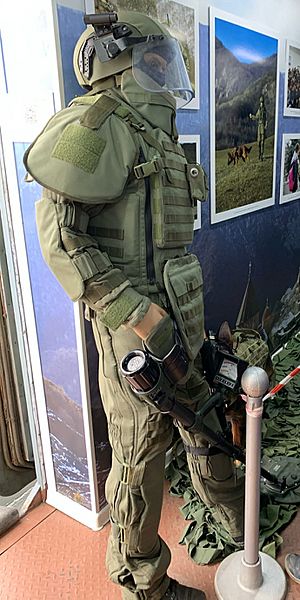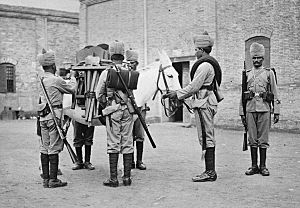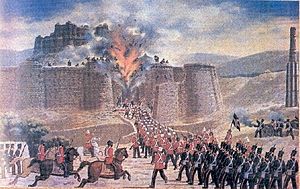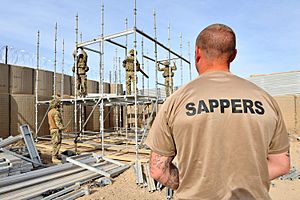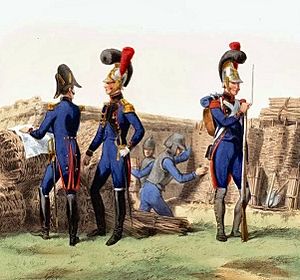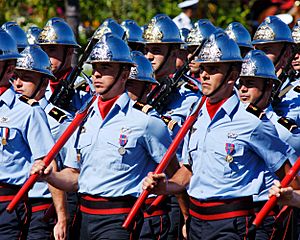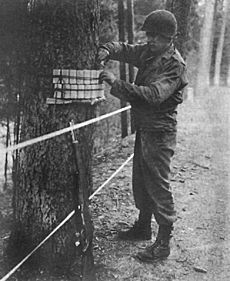Sapper facts for kids
A sapper is a special kind of soldier or combat engineer. Their main job is to help friendly forces move, defend themselves, and survive. They also make it harder for enemies to do the same. Sappers do many important tasks in the military. These include breaking through enemy defenses, blowing things up, building bridges, and setting up or clearing minefields. They also help build and fix roads and airfields. Sometimes, sappers also fight as regular soldiers if needed. The word "sapper" is used in armies like the British Army, other Commonwealth nations, and the U.S. military.
History of Sappers
What a Sapper Was
The word "sapper" first came from the French military. A sapper was someone who dug trenches. These trenches helped attacking armies get closer to enemy forts. They dug these trenches while under fire from the enemy's guns. The French word sapeur means "to undermine" or "to dig under." This digging was called "sapping" the enemy's defenses.
When an army attacked a fort, the fort's cannons were usually higher up. This gave them a longer firing range. The attacking army needed to move their own cannons closer. They did this by digging special trenches called sappe. Sappers used techniques developed by Vauban, a famous French engineer. They dug the trenches in a zigzag pattern. This way, enemy fire could not shoot straight down the trench. As they moved forward, they would set up spots for their cannons. These cannons would then fire at the fort's defenders. The sappers kept digging closer until the fort's walls could be broken through. So, sappers were experts at breaking down or getting around enemy forts.
What a Miner Was
Another term used for sappers, especially in the British Indian Army, was "miner." This is why some engineer groups were called "sappers and miners." After digging trenches, sappers would sometimes dig tunnels. These tunnels went from their trenches right under the fort walls. Then, they would place gunpowder charges inside the tunnels. When the charges exploded, they would destroy the wall. This allowed attacking soldiers to rush into the fort. This was very dangerous work for the sappers. Because these two jobs were done by the same soldiers, they were called "sappers and miners."
Sappers Around the World
Commonwealth Nations
In many Commonwealth armies, "Sapper" (often shortened to Spr) is a military rank. It's like the rank of "private" in other parts of the army. This is true for the Royal Engineers in the UK, and also in the Indian, Pakistani, Canadian, Australian, South African, Jamaican, and New Zealand armies. The rank of "sapper" was first used in 1856.
Australia
During World War I, Australian sappers did amazing work. In 1918, they repaired a bridge over the Jordan River in just five hours. The enemy had blown up the middle part of the bridge. While other soldiers crossed the river, the sappers worked through the night. They fixed the bridge so that vehicles and cannons could follow the next day.
Canada
In Canada, sappers are part of both the regular army and the reserves. The rank of sapper means a soldier has finished special engineer training. Canadian sappers have served in many major wars, including World War I, World War II, the Korean War, and the War in Afghanistan.
Their jobs include building bridges, creating obstacles, clearing enemy obstacles, and dealing with mines. They also handle explosives, provide clean water, build and fix roads and airfields, and build army camps. Sappers help friendly troops move, live, and fight on the battlefield. They also stop enemies from doing the same. The motto of the Canadian Military Engineers is Ubique, which means "everywhere."
Indian Army
In India, "sappers" can mean the rank of an engineer private. It's also used to talk about the entire Indian Army Corps of Engineers. There are three main combat engineer groups: the Madras Sappers, the Bengal Sappers, and the Bombay Sappers. Each group has many engineer regiments and smaller units. These groups came from the old sapper and miner groups of the British Indian Army.
Israel
In the Israel Defense Forces, a sapper (called palas in Hebrew) is a combat soldier who has completed special engineering training. Most sappers are in the Combat Engineering Corps. But there are also infantry sappers who work with infantry brigades.
Sappers in Israel get high-level infantry training. They learn combat skills, basic sabotage, how to plant and clear landmines, and how to use explosives. They also learn how to break through barriers, open routes, fight in trenches, and operate special combat engineering vehicles.
France
In France, "sapper" (sapeur) is the title for military combat engineers and also for firefighters. Military sappers are part of the Engineering Arm.
- Sapper: This is the title for combat engineers in most engineer regiments.
- Air Sapper: These are soldiers in the Air Engineering Regiment.
- Parachute Sapper: These sappers are part of the parachute brigade.
- Marine Sapper: These sappers are part of the Marine Brigade.
- Sapper firefighter: This is the title for firefighters in civilian fire services and the Paris Fire Brigade.
- Sapper-miner: Since World War Two, these are combat engineers who specialize in clearing mines.
History of French Sappers
The French Corps of Engineers was created in the late 1600s. Soldiers who destroyed enemy forts by digging trenches were called sappers. Those who dug tunnels were called miners. Over time, their jobs grew. They also had "conductor" sappers for logistics and "telegraph" sappers for communications. In 1875, the difference between miners and sappers was removed. All members of the Corps of Engineers were called sappers.
French Firefighters
The first military sapper fire company was created by Napoleon in 1810. They protected the Imperial palaces. In 1811, the Paris Fire Service became a military unit called the Paris Sappers-Firefighters Battalion. Many other cities also used military ranks and organization for their firefighters. Today, "sapper-firefighter" is a common title for civilian and Paris firefighters in France.
French Pioneers
Since the 1700s, some French Army battalions had small units of "pioneers." Their job was to move forward under enemy fire. They would destroy obstacles and clear the way for the rest of the soldiers. This was very dangerous work. Because of this, pioneers were allowed special privileges, like wearing beards. They also traditionally wore leather aprons and gloves.
Most pioneer units disappeared by the mid-1900s. Only the French Foreign Legion still uses a pioneer unit. They mostly perform in parades. They bring back the old symbols of Napoleonic pioneers: the beard, the axe, the leather apron, and gloves. When the Legion parades, the pioneer unit leads the way. This shows their traditional role of "opening the way" for the troops.
Italy
The Italian Army uses different terms for its engineers. "Guastatori" are combat engineers. "Pionieri" are construction engineers. "Pontieri" are bridge-building engineers. "Ferrovieri" are railroad engineers.
Portugal
In Portugal, "sapper" is used in both the military and for civilians. In the Portuguese Army, an engineering sapper is a soldier with special combat engineer training. An infantry sapper is an infantry soldier with similar training. A NBC sapper specializes in nuclear, biological, and chemical warfare.
Civilian professional firefighters in major cities are called sapper-firefighters. The largest unit is in Lisbon. There are also forest sappers. These professionals clean and maintain forests. They also prevent and fight forest fires.
Pakistan Army
In the Pakistan Army, sapper officers do combat and regular engineer duties. The Corps is led by the Engineer-in-Chief. This corps has been around since 1780. It became its modern form in 1947 when Pakistan became independent. They have fought in all of Pakistan's wars. They also built the Pakistan part of the Karakoram Highway.
United States Army
In the United States Army, sappers are combat engineers. They support the soldiers on the front lines. They have fought in every war in U.S. history. For example, after the Siege of Yorktown, General Washington praised his chief engineer for his "brilliant proofs of his military genius."
Soldiers can also earn a "sapper" designation. The U.S. Army allows soldiers to wear special tabs on their uniform. The Sapper Tab is one of these. To earn it, a soldier must graduate from the Sapper Leader Course. This course is 28 days long and very challenging. It teaches combat engineers important skills and advanced techniques. It also helps build teamwork. The course includes training in demolitions, using explosives, and mountaineering. It ends with an intense field exercise. The course is mainly for U.S. Army and USMC combat engineers.
PAVN and Viet Cong
The PAVN and Viet Cong sappers were called "special task" units by U.S. forces. Thousands of these specially trained fighters served in these commando-sapper units. They were organized as independent groups. They were very good at causing heavy damage, even without many firearms. During the Vietnam War, they used bombs, mines, explosives, and grenades.
These elite units attacked American and South Vietnamese troops. They also led attacks during the final Ho Chi Minh Campaign in 1975. They captured key roads and bridges, destroyed buildings, and attacked enemy command centers. They also placed explosives on U.S. boats. This helped the PAVN's fast-moving forces advance quickly.
One famous sapper attack was during the Battle of Fire Base Mary Ann. A small group of Viet Cong sappers surprised a larger U.S. force. They threw explosives at the command bunker and destroyed all communication equipment.
Ottoman Empire
The Ottoman Empire had an infantry group called Lağımcılar Ocağı, which means "Sapper Corps." These soldiers were used in most of the Empire's sieges. Their job was to destroy enemy forts and defenses.
Honors
Sapper Island, in Ontario, Canada, was named to honor sappers. This includes those who graduated from the Royal Military College of Canada.
In Fiction
In the 1978 song "Khe Sanh" by the Australian band Cold Chisel, the singer mentions sappers. He says, "I left my heart to the sappers round Khe Sanh." However, the sappers at the real Battle of Khe Sanh were from U.S., South Vietnamese, and North Vietnamese units.
In the 2008 science-fiction book The Last Colony, a made-up "sapper field" technology is used. It stops enemy weapons from working.
See also
- Pioneer sergeant
- Assault pioneer
- Trooper (rank)
- Viet Cong and PAVN Sapper attacks


